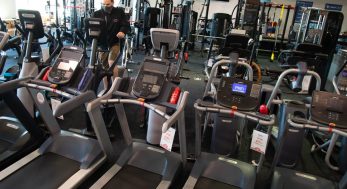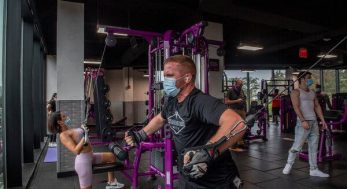There’s no sugar-coating it: If you’re back at the gym after months of minimal, improv workouts at home, you’re going to be panting and sweating buckets to get back into shape.
When it comes to fitness, it’s a matter of “use it or lose it”. If your last serious session was before the circuit breaker started in April, you may well have to start all over again.
“You’re only as good as your last training session,” said Sydney-based sports scientist Professor Tony Boutagy. “In other words, you only get health benefits from a session for up to about 48 hours afterwards.”
READ: Phase 2: Expert tips on how to stay safe in the gym, yoga studio and swimming pool
SO WHAT’S THE DAMAGE?
It depends on your fitness level prior to that COVID-19-induced hibernation. The higher your fitness level, the greater the effects of de-training, said Adjunct Associate Professor Benedict Tan, who’s also the chief of Changi General Hospital’s Sport & Exercise Medicine Department.
“For instance, a professional bodybuilder with a lot of lean muscle mass will notice significant loss of muscle mass. He may not notice any loss of cardiovascular endurance as it was not high in the first place,” he said.
“Likewise, a fast marathon runner will report that endurance, rather than strength, is the first measure to be impacted.”
But other than your stamina and muscle strength, there are other aspects of your health that can be affected, too. Here’s the breakdown:
- Within 10 days of not exercising: Your mind feels hazy and you are easily irritated
You’d think that not doing much all day long for more than a week on a stretch is just the break you need, right? The brain fog and sense of irritability after days of inactivity are signs that you are overdoing the R&R.
Those experiences could be caused by a reduced blood flow to your hippocampus, the part of the brain that’s associated with memory and emotion, according to a small study published in the journal Frontiers In Aging Neuroscience.
That was what researchers found when they subjected 12 master endurance runners above the age of 50 to a 10-day hiatus from running.
While the runners didn’t show cognitive changes, 29 per cent of them displayed signs of impaired glucose tolerance or insulin resistance – a factor that leads to Type 2 diabetes. In fact, the signs of insulin resistance include lethargy and difficulty in concentrating.
The higher your fitness level, the greater the effects of de-training.
- Within two weeks of not exercising: You feel like dying when climbing the stairs
Climbing a flight of stairs can already feel harder after two weeks (or even just days) of stopping training, said Justin Wee, the principal physiotherapist at Tan Tock Seng Hospital’s Department of Physiotherapy.
That’s because your VO2 max – an index that measures how efficiently your body uses oxygen during aerobic activity – drops, said Dr Farah Hameed, a sports medicine physician with ColumbiaDoctors, on health.com.
The lower your VO2 max, the harder you’ll pant when doing cardiovascular work. Conversely, the higher your VO2 max, the more energy you’ll be able to produce to run after the bus or achieve a new personal best for your 2.4-kilometre run.
And it gets worse the more days you devote to couch potato-ing: After four weeks, it can drop by 15 per cent; after three months, it plummets by about 20 per cent, said Dr Hameed.
Strength-wise, be mentally prepared to lose up to 30 per cent of it, said Wee. If you were able to bench press 100kg, you may only be able to lift just 70kg after a fortnight of non-exercise.
Your blood glucose level is affected, too. A study in the Journal Of Applied Physiology found that people who improved their blood glucose levels over eight months of resistance and aerobic exercise lost almost half of the benefits after 14 days of inactivity. Turns out, you snooze, you lose.
READ: Using TikTok and other tips to stay motivated while exercising during the circuit breaker
- Within four weeks of not exercising: You feel tired easily
Your cardiovascular and circulatory systems take a beating at this point. For one, your stroke volume is reduced by about 10 per cent, said Wee. Stroke volume is the amount of blood pumped by your heart per beat, and a lower stroke volume means less blood is circulated with each heart beat.
Your plasma volume also drops by about 10 per cent, said Wee, if you stop exercising for a month. Plasma is a yellowish liquid that makes up 55 per cent of the body’s total blood volume. While red blood cells transport oxygen, plasma lets your heart pump more blood volume. So if there is less blood volume to carry the oxygen to your muscles, they’ll tire out faster.
When it comes to strength, it apparently diminishes slower than endurance. In a 2011 study in the Journal Of Strength And Conditioning, when a group of men stopped doing resistance training, they still had some of their strength gains up to 24 weeks later.
- Within eight weeks of not exercising: You’ve gained weight
At about six weeks, you’d probably already be seeing a change either in the mirror or the number on the scale, said Dr Hameed.
Even elite athletes aren’t immune. A 2012 study in the Journal Of Strength And Conditioning Research found that competitive swimmers, who took a five-week break from their training, experienced a 12 per cent increase in body fat, and a boost in their body weight and waist circumference.
Elite taekwondo athletes, who took an eight-week hiatus from exercise also got fat. In a 2016 study, they experienced an increase in body fat and a decrease in muscle mass.
READ: Feeling tired while working from home? 5 easy exercises to boost your energy
HOW DO WE TEST HOW MUCH FITNESS WE’VE LOST?
Dr Tan recommended the following tests for gauging your current post-CB fitness in terms of stamina, strength, flexibility and balance.
Stamina:
- Run 2km and time yourself.
Strength:
- To test maximum strength: Record the heaviest weight you can lift.
- To test strength endurance: Measure the maximum number of repetitions you can perform at one go. Do push-ups or pull-ups for upper body strength endurance, and squats or lunges for lower body endurance. Or time how long you can hold a static position such as front plank.
- To test explosive strength: Measure the maximum height you can scale in a single jump.
Balance:
- Stand on one leg and measure the length of time you can hold the position before having to put your foot down.
Flexibility:
- Bend forward and stretch your hands towards the floor. Measure the distance between your fingertips and the floor.
- For upper limb flexibility, place one hand overhead and bring it down your back. Place the other hand behind your back and reach upwards towards the other hand. Have someone measure the distance between the two hands.
HOW DO YOU GET BACK IN THE GAME?
The key is to put aside your ego, and start slow and easy. Don’t assume that you are still as fit as your pre-COVID-19 self.
“Listen to your body. If you don’t feel comfortable performing any exercises, slow down, reduce the resistance or do fewer repetitions,” said Wee. It is also helpful to warm up prior to your workout, especially after a long period of inactivity.
As a rule of the thumb, said Dr Tan, resume your activities at half the intensity, frequency, and duration relative to what you used to do. “Over the weeks, progressively step up the intensity by 10 per cent each week.”
To find out if your starting point is excessive, Dr Tan recommended taking note of your post-exercise aches and soreness.
“If you do not experience any soreness or muscle aches, it is likely that you were too conservative. If you experience excessive soreness and have difficulty going about your daily activities, it is likely that you were too ambitious with your fitness routine. If the soreness is bearable and you can comfortably go about your daily activities, you have struck the right balance.”
But ultimately, don’t worry. “The loss of fitness is reversible. When you start exercising regularly again, it will return,” said Wee.

